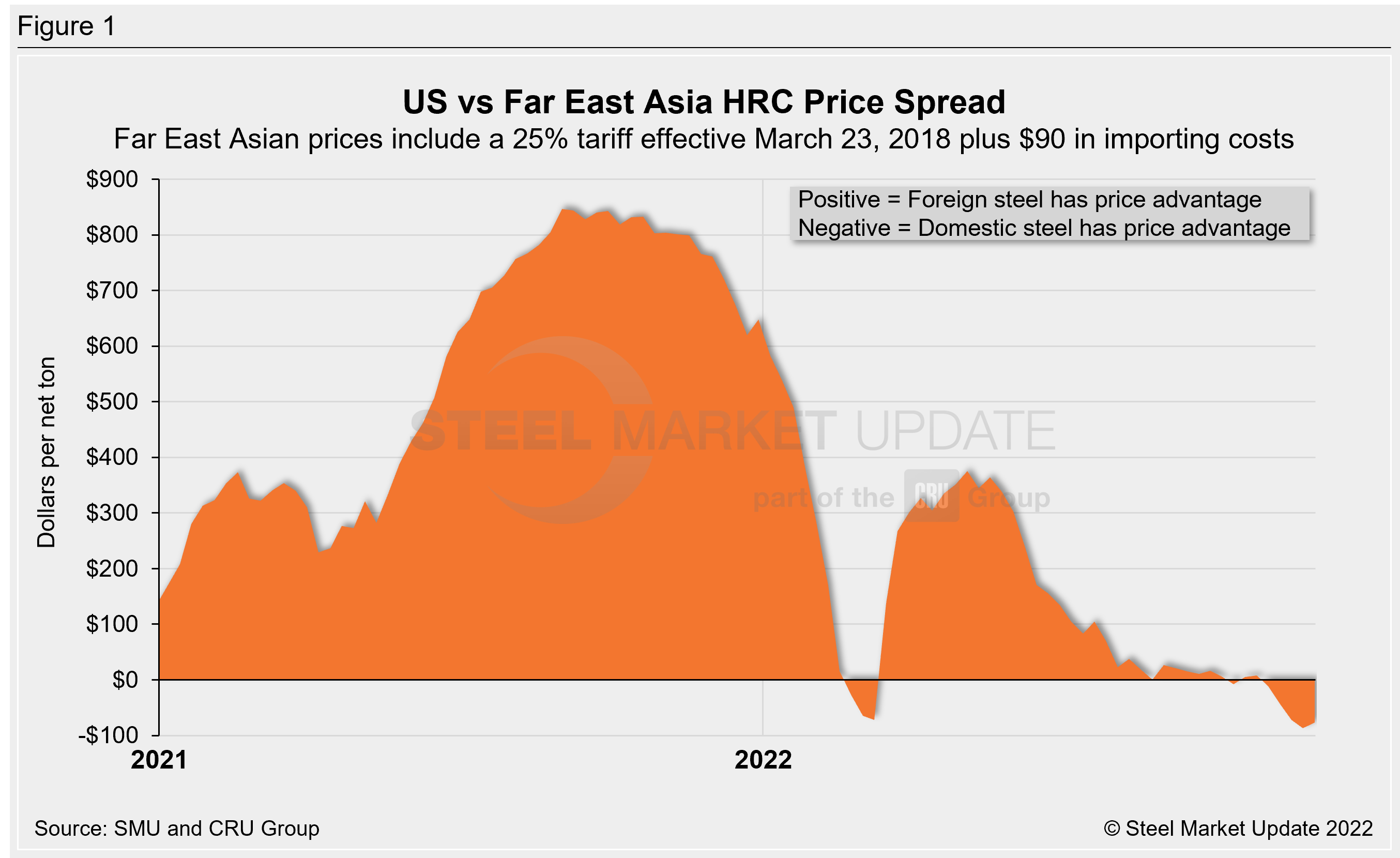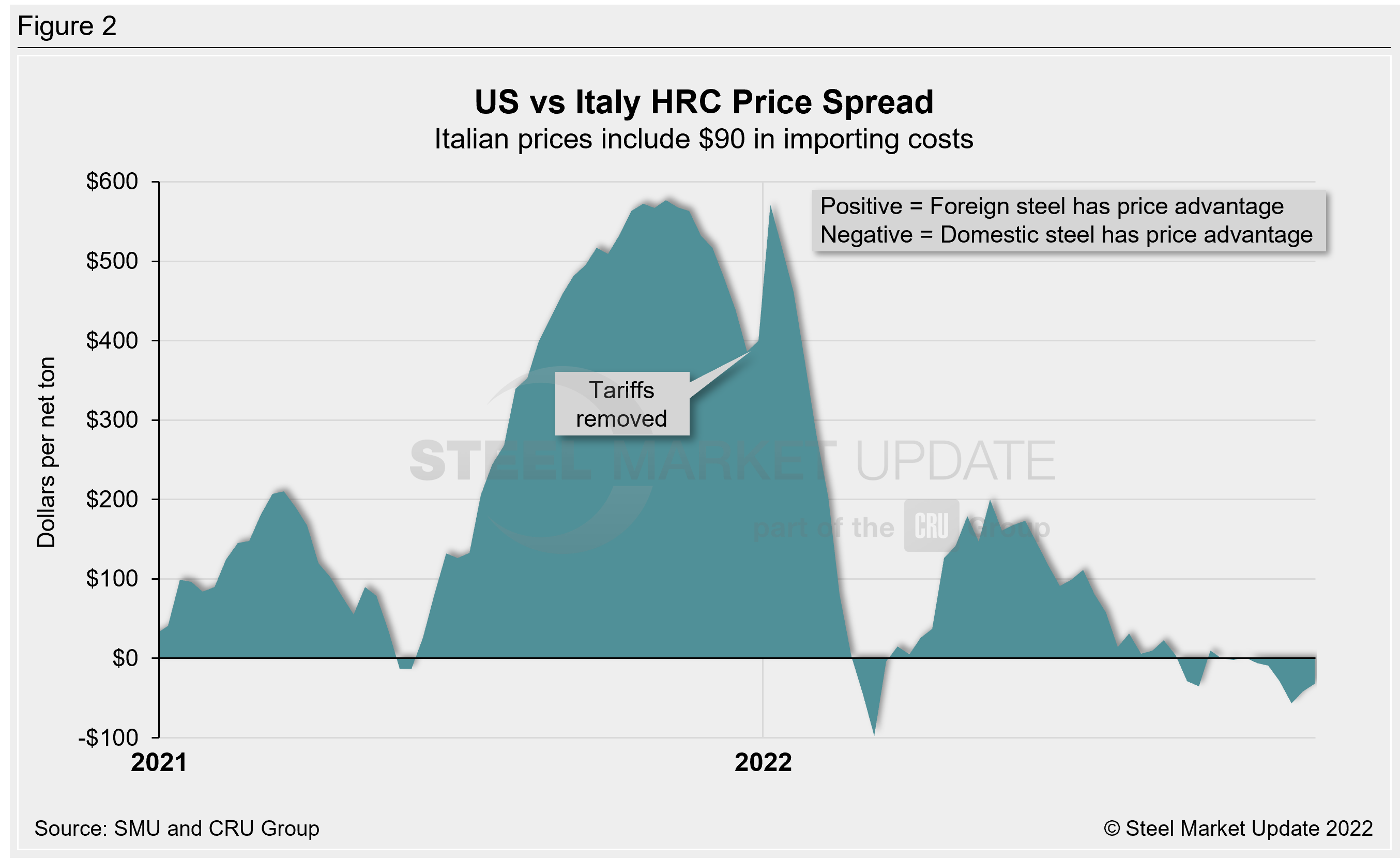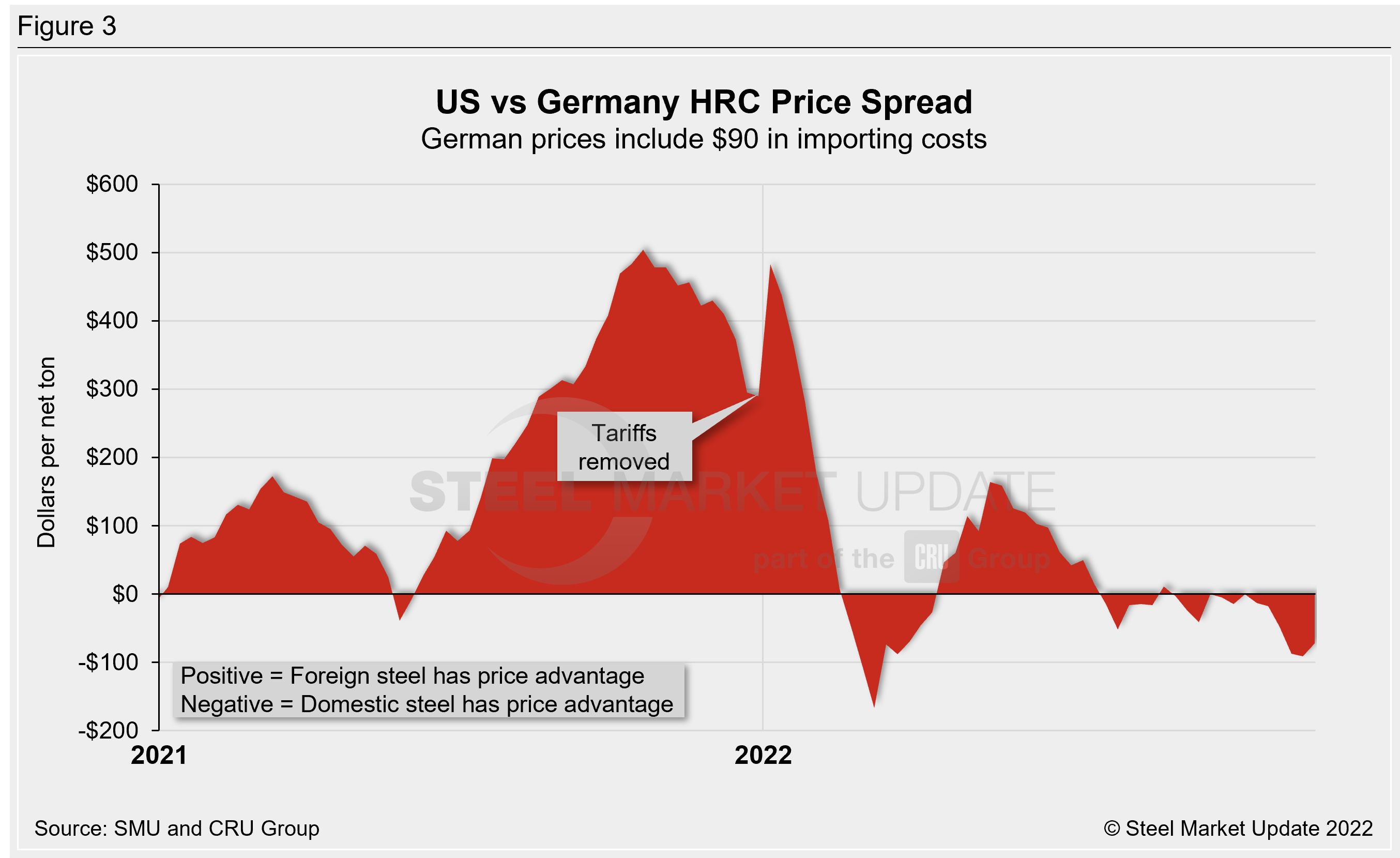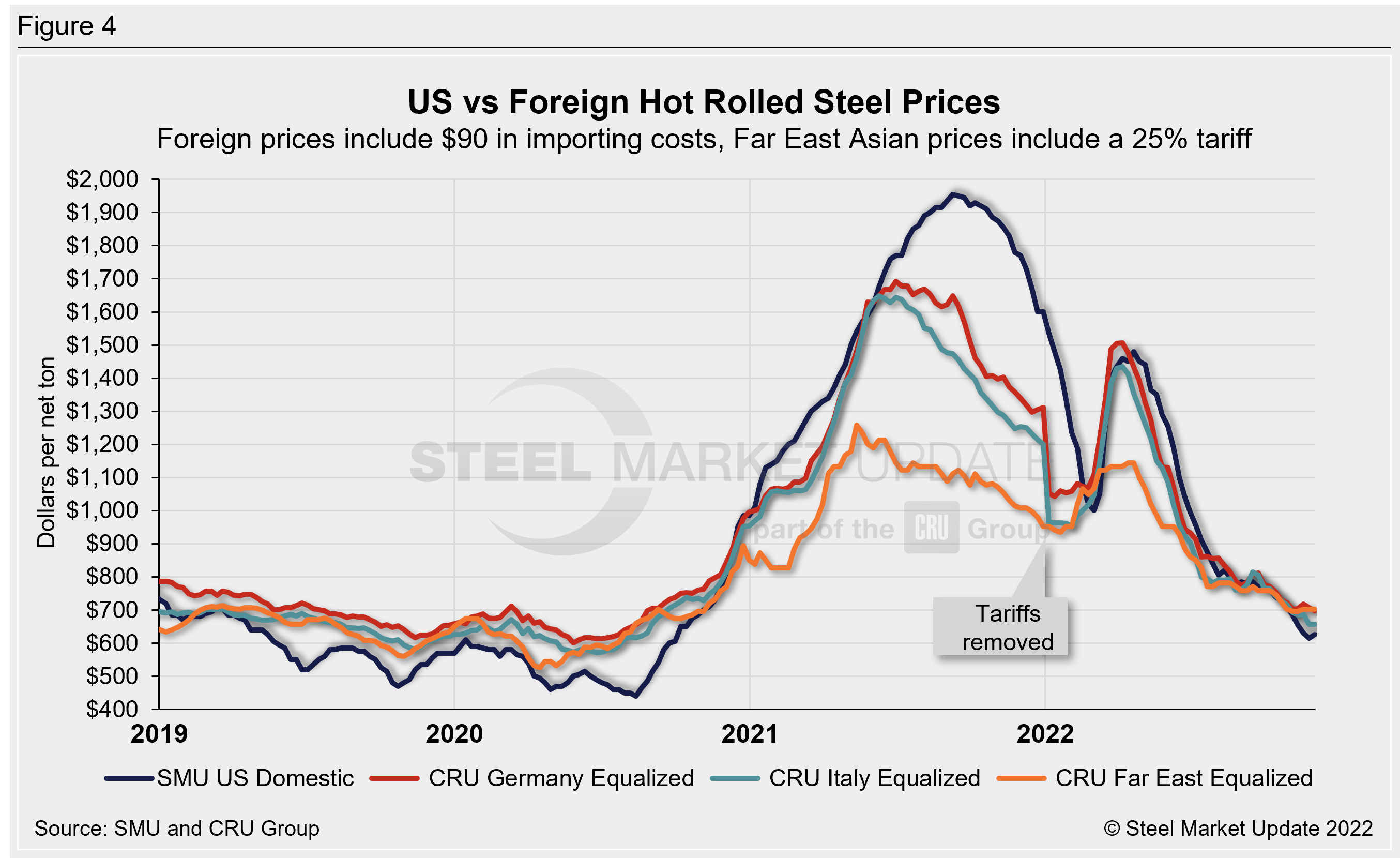Economy

Domestic Hot Rolled Steel Now 5-12% Cheaper Than Imports
Written by Brett Linton
December 1, 2022
Domestic hot-rolled coil (HRC) continues to hold a sizeable price advantage over imports, according to Steel Market Update’s latest analysis on foreign and domestic prices. US HRC is approximately 5–12% cheaper than foreign prices this week, after consideration of freight costs, trader margins and any applicable tariffs. This is the fifth consecutive week that US prices have been cheaper than foreign prices for all three regions we follow.
![]() SMU uses the following calculation to identify the theoretical spread between foreign HRC prices (delivered to US ports) and domestic HRC prices (FOB domestic mills): Our analysis compares the SMU US HRC weekly index to the CRU HRC weekly indices for Germany, Italy, and Far East Asian ports. This is only a theoretical calculation because costs to import can vary greatly and often fluctuate, which influences the true market spread.
SMU uses the following calculation to identify the theoretical spread between foreign HRC prices (delivered to US ports) and domestic HRC prices (FOB domestic mills): Our analysis compares the SMU US HRC weekly index to the CRU HRC weekly indices for Germany, Italy, and Far East Asian ports. This is only a theoretical calculation because costs to import can vary greatly and often fluctuate, which influences the true market spread.
In consideration of freight costs, handling, and trader margin, we add $90 per ton to all foreign prices to provide an approximate “CIF US ports price” that can be compared against the SMU domestic HRC price. Buyers should use our $90 per ton figure as a benchmark, adjusting it as necessary based on their own shipping and handling costs. If you have experience importing foreign steel and want to share your thoughts on these costs, we welcome your insight and comments: Brett@SteelMarketUpdate.com.
Far East Asian HRC (East and Southeast Ports)
As of Wednesday, Nov. 30, the CRU Far East Asian HRC price remained unchanged week-over-week at $490 per net ton ($540 per metric ton), up $5 from levels one month prior. Adding a 25% tariff and $90 per ton in estimated import costs, the delivered price of Far East Asian HRC to the US is $702 per ton. The latest SMU hot rolled average is $625 per ton, up $10 from last week but down $60 compared to one month ago.
Therefore, US-produced HRC is now $77 per ton cheaper than steel imported from Far East Asia. This is the second largest price appeal that domestic HRC has had over Far East Asian HRC this year, with the highest occurring last week at $87 per ton. Prior to that, we have to look back to September 2020 to find similar spreads. One month ago domestic prices held a discount of $12 per ton over foreign steel. Prior to October, Far East Asian prices had held the advantage since mid-March; the differential peaked at $375 per ton in May. The widest price advantage recorded for Far East Asian prices was just over a year ago, at $847 per ton in September 2021.

Italian HRC
Italian HRC prices were flat week-over-week at $567 per net ton ($625 per metric ton) this week, $37 less than levels one month ago. After adding import costs, the delivered price of Italian HRC is approximately $657 per ton.
Domestic HRC is now theoretically $32 per ton cheaper than imported Italian HRC. Last week the spread was $42 per ton (with US prices holding the advantage). Two weeks ago we saw a spread of $57 per ton, the widest spread seen since March. One month ago, prices between these two regions were $9 apart, favoring US steel. The highest spread this year was $200 per ton in May, when Italian prices held a considerable advantage. Before the removal of the 25% Section 232 tariff, the spread one year ago reached $577 per ton in November, the largest in SMU’s data history.

German HRC
CRU’s latest German HRC price decreased $9 per ton week-over-week to $607 per net ton ($669 per metric ton), down $5 compared to prices one month ago. After adding import costs, the delivered price of German HRC is approximately $697 per ton.
Accordingly, domestic HRC is now theoretically $72 per ton cheaper than imported German HRC. Last week the spread was $91 per ton, the largest margin (in favor US prices) seen since March. One month ago domestic prices held a discount of $18 per ton over foreign steel. Domestic HRC has held this price advantage for all but three weeks since late July. German HRC held the price advantage for the three months prior to that, having reached a 2022 high of $164 per ton in May. Prior to the removal of the 25% tariff, the October 2021 spread of $504 per ton was the widest in SMU’s data history.

The graph below compares all four price indices and highlights the effective date of the tariffs. Foreign prices are referred to as “equalized,” meaning they have been adjusted to include importing costs (and tariffs in some cases) for a like-for-like comparison against the US price.

Notes: Freight is an important part of the final determination on whether to import foreign steel or buy from a domestic mill supplier. Domestic prices are referenced as FOB the producing mill, while foreign prices are CIF the port (Houston, NOLA, Savannah, Los Angeles, Camden, etc.). Inland freight, from either a domestic mill or from the port, can dramatically impact the competitiveness of both domestic and foreign steel. When considering lead times, a buyer must take into consideration the momentum of pricing both domestically and in the world markets. In most circumstances, domestic steel will deliver faster than foreign steel ordered on the same day.
Effective Jan. 1, 2022, the traditional Section 232 tariff no longer applies to most imports from the European Union. It has been replaced by a tariff rate quota (TRQ). Therefore, the German and Italian price comparisons in this analysis no longer include a 25% tariff. SMU still includes the 25% S232 tariff on foreign prices from other countries. We do not include any antidumping (AD) or countervailing duties (CVD) in this analysis.
By Brett Linton, Brett@SteelMarkeUpdate.com

Brett Linton
Read more from Brett LintonLatest in Economy

Architecture billings continue to slide in March
Architecture firms said billings continued to decline in March, according to the latest Architecture Billings Index (ABI) released by the American Institute of Architects (AIA) and Deltek.

Beige Book shows concerns about trade policy
Manufacturing was mixed, but two-thirds of districts said activity was little changed or had declined.

New York state manufacturing index drops again in April
Firms were pessimistic, with the future general business conditions index falling to its second lowest reading in the more than 20-year history of the survey

Construction adds 13,000 jobs in March
The construction sector added 13,000 jobs, seasonally adjusted, in March, but tariffs could undermine the industry.

Supply chains, end-users brace for impact from tariffs
Supply chains are working through what the tariffs mean for them
